Impacts of HIV/AIDS on Individuals, Families and Community in Australia
VerifiedAdded on 2022/11/13
|13
|3413
|379
AI Summary
This report discusses the impacts of HIV/AIDS on individuals, families and community in Australia. It also covers the role of nurses and primary health care principles in addressing the issue. Nursing interventions and health promotion strategies are also mentioned.
Contribute Materials
Your contribution can guide someone’s learning journey. Share your
documents today.

Running Head: HIV
0
HIV/AIDS
student
7/27/2019
0
HIV/AIDS
student
7/27/2019
Secure Best Marks with AI Grader
Need help grading? Try our AI Grader for instant feedback on your assignments.
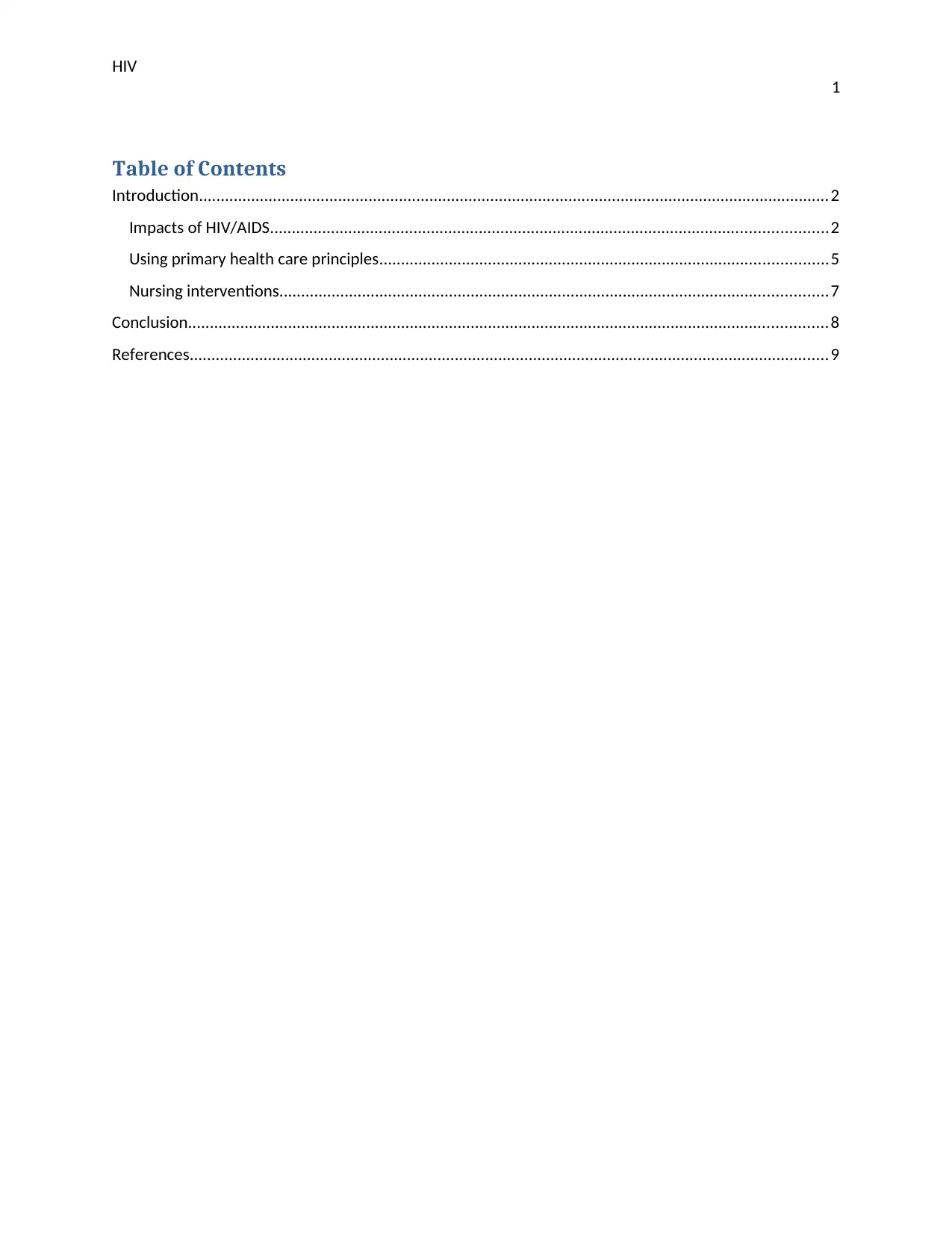
HIV
1
Table of Contents
Introduction.................................................................................................................................................2
Impacts of HIV/AIDS................................................................................................................................2
Using primary health care principles.......................................................................................................5
Nursing interventions..............................................................................................................................7
Conclusion...................................................................................................................................................8
References...................................................................................................................................................9
1
Table of Contents
Introduction.................................................................................................................................................2
Impacts of HIV/AIDS................................................................................................................................2
Using primary health care principles.......................................................................................................5
Nursing interventions..............................................................................................................................7
Conclusion...................................................................................................................................................8
References...................................................................................................................................................9
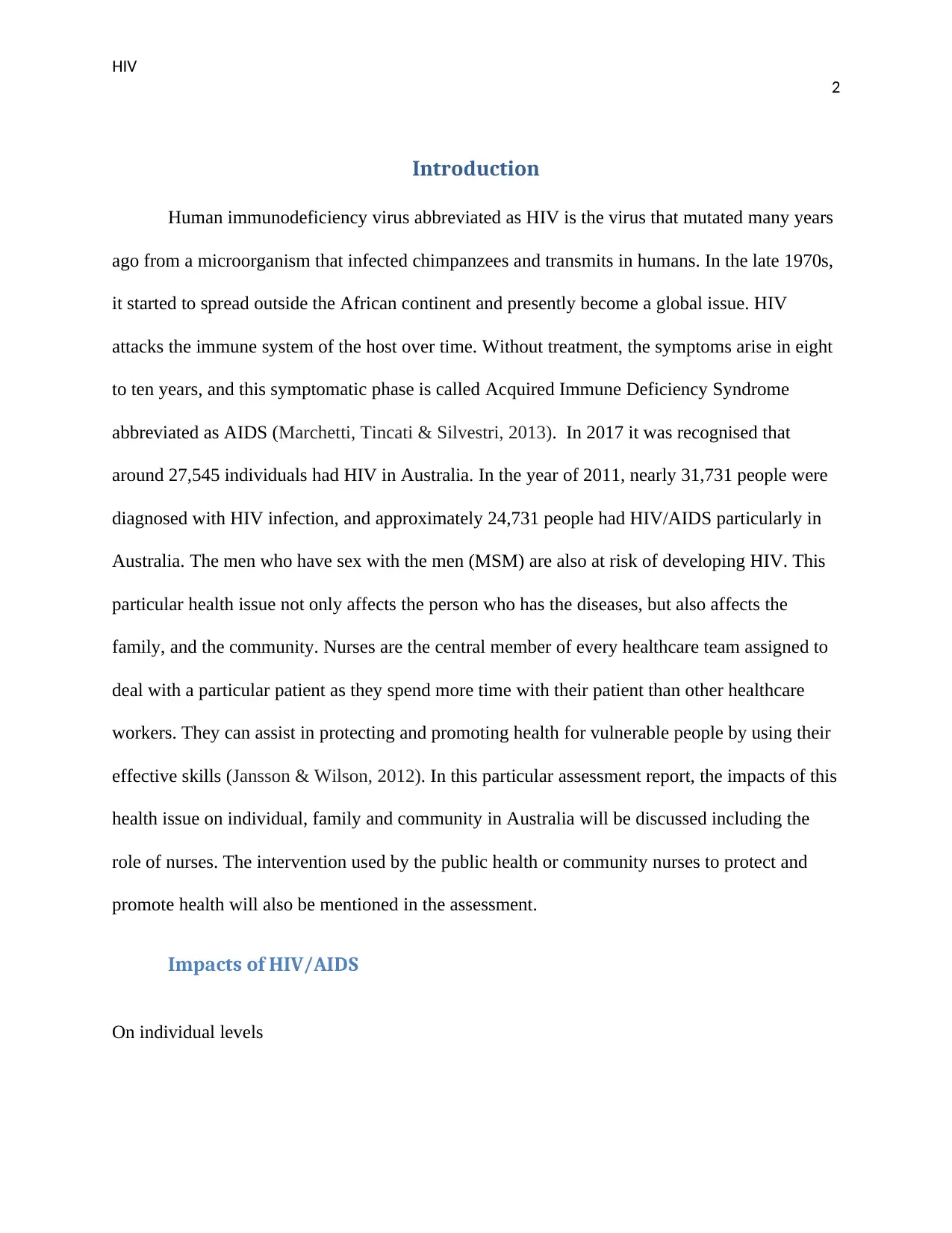
HIV
2
Introduction
Human immunodeficiency virus abbreviated as HIV is the virus that mutated many years
ago from a microorganism that infected chimpanzees and transmits in humans. In the late 1970s,
it started to spread outside the African continent and presently become a global issue. HIV
attacks the immune system of the host over time. Without treatment, the symptoms arise in eight
to ten years, and this symptomatic phase is called Acquired Immune Deficiency Syndrome
abbreviated as AIDS (Marchetti, Tincati & Silvestri, 2013). In 2017 it was recognised that
around 27,545 individuals had HIV in Australia. In the year of 2011, nearly 31,731 people were
diagnosed with HIV infection, and approximately 24,731 people had HIV/AIDS particularly in
Australia. The men who have sex with the men (MSM) are also at risk of developing HIV. This
particular health issue not only affects the person who has the diseases, but also affects the
family, and the community. Nurses are the central member of every healthcare team assigned to
deal with a particular patient as they spend more time with their patient than other healthcare
workers. They can assist in protecting and promoting health for vulnerable people by using their
effective skills (Jansson & Wilson, 2012). In this particular assessment report, the impacts of this
health issue on individual, family and community in Australia will be discussed including the
role of nurses. The intervention used by the public health or community nurses to protect and
promote health will also be mentioned in the assessment.
Impacts of HIV/AIDS
On individual levels
2
Introduction
Human immunodeficiency virus abbreviated as HIV is the virus that mutated many years
ago from a microorganism that infected chimpanzees and transmits in humans. In the late 1970s,
it started to spread outside the African continent and presently become a global issue. HIV
attacks the immune system of the host over time. Without treatment, the symptoms arise in eight
to ten years, and this symptomatic phase is called Acquired Immune Deficiency Syndrome
abbreviated as AIDS (Marchetti, Tincati & Silvestri, 2013). In 2017 it was recognised that
around 27,545 individuals had HIV in Australia. In the year of 2011, nearly 31,731 people were
diagnosed with HIV infection, and approximately 24,731 people had HIV/AIDS particularly in
Australia. The men who have sex with the men (MSM) are also at risk of developing HIV. This
particular health issue not only affects the person who has the diseases, but also affects the
family, and the community. Nurses are the central member of every healthcare team assigned to
deal with a particular patient as they spend more time with their patient than other healthcare
workers. They can assist in protecting and promoting health for vulnerable people by using their
effective skills (Jansson & Wilson, 2012). In this particular assessment report, the impacts of this
health issue on individual, family and community in Australia will be discussed including the
role of nurses. The intervention used by the public health or community nurses to protect and
promote health will also be mentioned in the assessment.
Impacts of HIV/AIDS
On individual levels
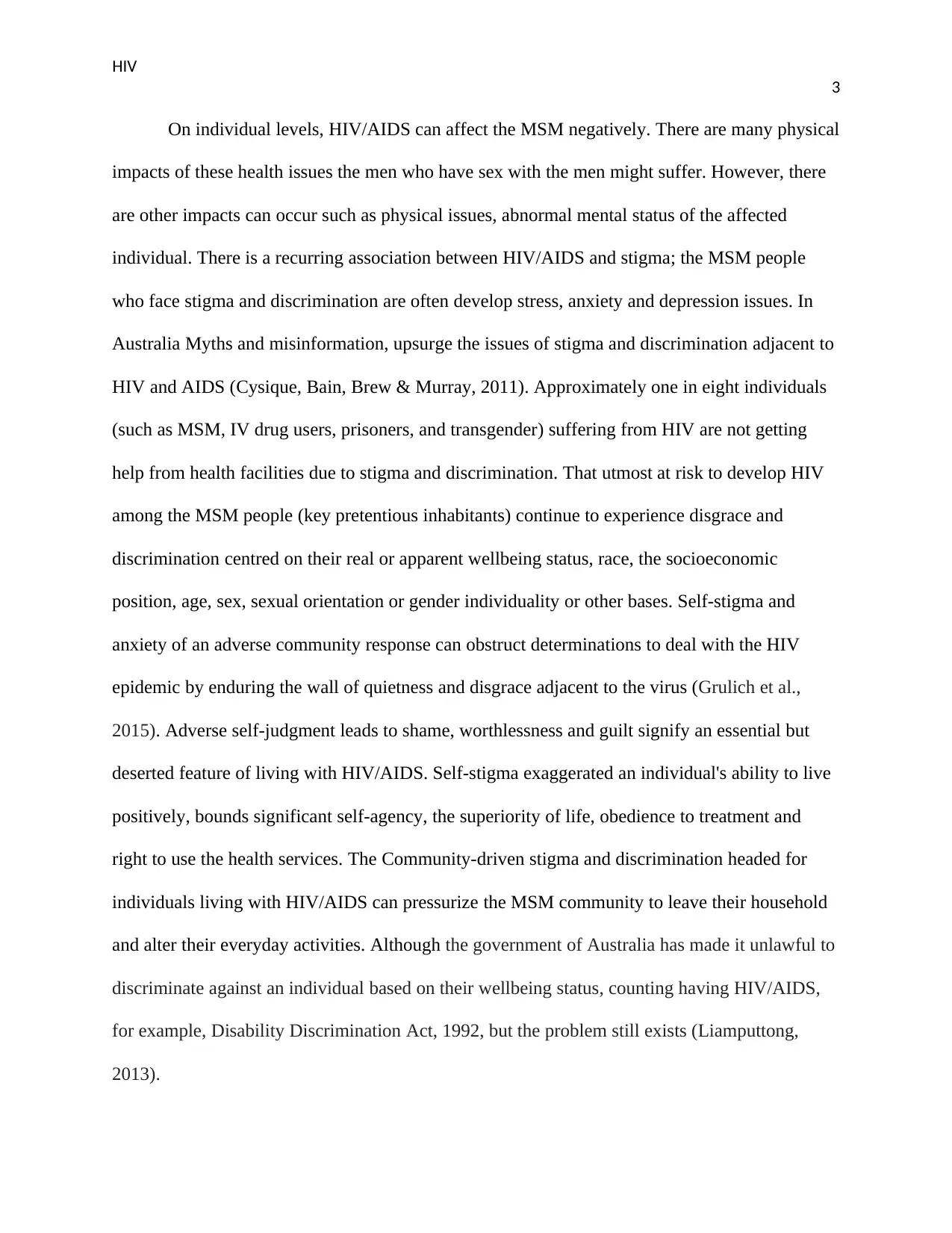
HIV
3
On individual levels, HIV/AIDS can affect the MSM negatively. There are many physical
impacts of these health issues the men who have sex with the men might suffer. However, there
are other impacts can occur such as physical issues, abnormal mental status of the affected
individual. There is a recurring association between HIV/AIDS and stigma; the MSM people
who face stigma and discrimination are often develop stress, anxiety and depression issues. In
Australia Myths and misinformation, upsurge the issues of stigma and discrimination adjacent to
HIV and AIDS (Cysique, Bain, Brew & Murray, 2011). Approximately one in eight individuals
(such as MSM, IV drug users, prisoners, and transgender) suffering from HIV are not getting
help from health facilities due to stigma and discrimination. That utmost at risk to develop HIV
among the MSM people (key pretentious inhabitants) continue to experience disgrace and
discrimination centred on their real or apparent wellbeing status, race, the socioeconomic
position, age, sex, sexual orientation or gender individuality or other bases. Self-stigma and
anxiety of an adverse community response can obstruct determinations to deal with the HIV
epidemic by enduring the wall of quietness and disgrace adjacent to the virus (Grulich et al.,
2015). Adverse self-judgment leads to shame, worthlessness and guilt signify an essential but
deserted feature of living with HIV/AIDS. Self-stigma exaggerated an individual's ability to live
positively, bounds significant self-agency, the superiority of life, obedience to treatment and
right to use the health services. The Community-driven stigma and discrimination headed for
individuals living with HIV/AIDS can pressurize the MSM community to leave their household
and alter their everyday activities. Although the government of Australia has made it unlawful to
discriminate against an individual based on their wellbeing status, counting having HIV/AIDS,
for example, Disability Discrimination Act, 1992, but the problem still exists (Liamputtong,
2013).
3
On individual levels, HIV/AIDS can affect the MSM negatively. There are many physical
impacts of these health issues the men who have sex with the men might suffer. However, there
are other impacts can occur such as physical issues, abnormal mental status of the affected
individual. There is a recurring association between HIV/AIDS and stigma; the MSM people
who face stigma and discrimination are often develop stress, anxiety and depression issues. In
Australia Myths and misinformation, upsurge the issues of stigma and discrimination adjacent to
HIV and AIDS (Cysique, Bain, Brew & Murray, 2011). Approximately one in eight individuals
(such as MSM, IV drug users, prisoners, and transgender) suffering from HIV are not getting
help from health facilities due to stigma and discrimination. That utmost at risk to develop HIV
among the MSM people (key pretentious inhabitants) continue to experience disgrace and
discrimination centred on their real or apparent wellbeing status, race, the socioeconomic
position, age, sex, sexual orientation or gender individuality or other bases. Self-stigma and
anxiety of an adverse community response can obstruct determinations to deal with the HIV
epidemic by enduring the wall of quietness and disgrace adjacent to the virus (Grulich et al.,
2015). Adverse self-judgment leads to shame, worthlessness and guilt signify an essential but
deserted feature of living with HIV/AIDS. Self-stigma exaggerated an individual's ability to live
positively, bounds significant self-agency, the superiority of life, obedience to treatment and
right to use the health services. The Community-driven stigma and discrimination headed for
individuals living with HIV/AIDS can pressurize the MSM community to leave their household
and alter their everyday activities. Although the government of Australia has made it unlawful to
discriminate against an individual based on their wellbeing status, counting having HIV/AIDS,
for example, Disability Discrimination Act, 1992, but the problem still exists (Liamputtong,
2013).
Secure Best Marks with AI Grader
Need help grading? Try our AI Grader for instant feedback on your assignments.
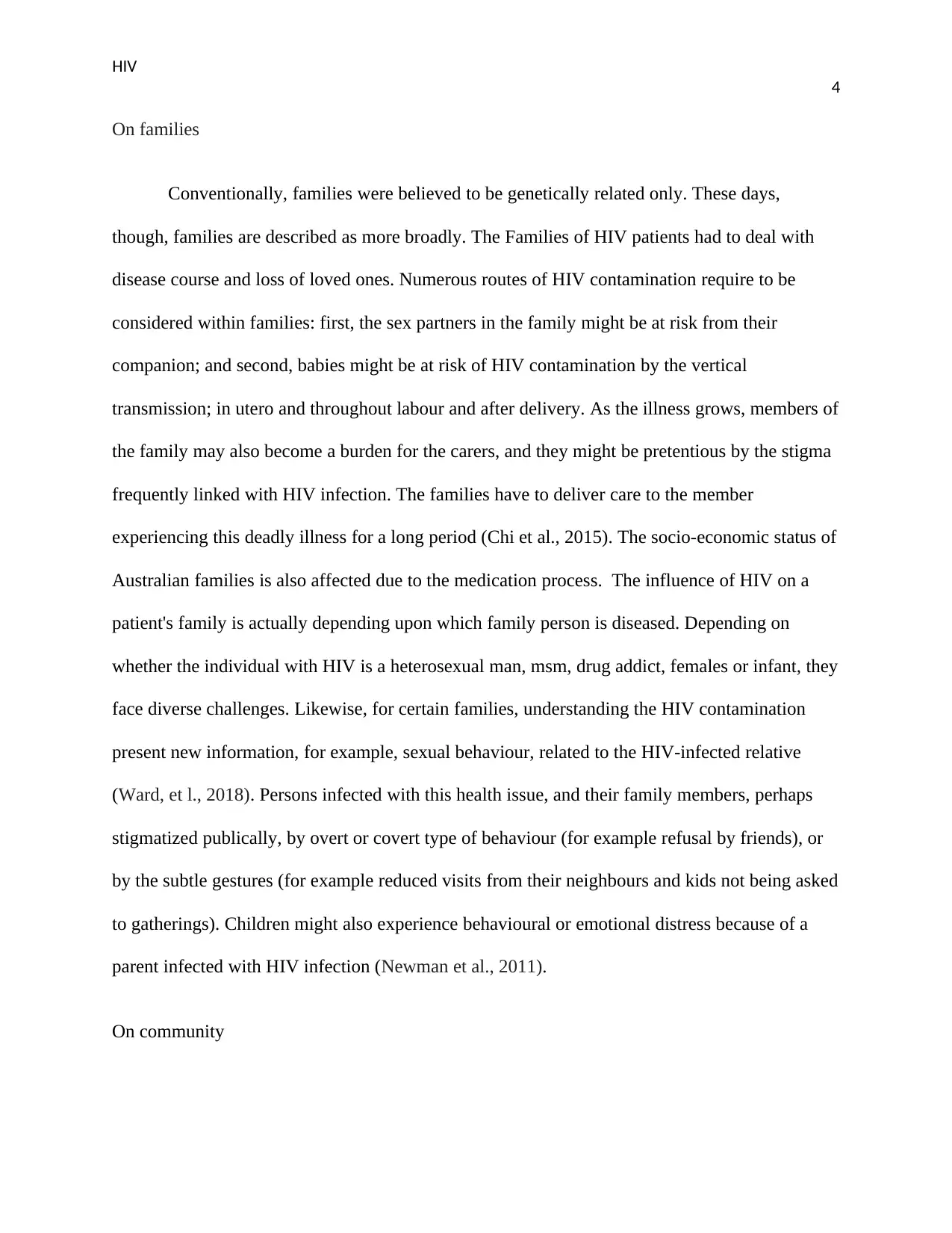
HIV
4
On families
Conventionally, families were believed to be genetically related only. These days,
though, families are described as more broadly. The Families of HIV patients had to deal with
disease course and loss of loved ones. Numerous routes of HIV contamination require to be
considered within families: first, the sex partners in the family might be at risk from their
companion; and second, babies might be at risk of HIV contamination by the vertical
transmission; in utero and throughout labour and after delivery. As the illness grows, members of
the family may also become a burden for the carers, and they might be pretentious by the stigma
frequently linked with HIV infection. The families have to deliver care to the member
experiencing this deadly illness for a long period (Chi et al., 2015). The socio-economic status of
Australian families is also affected due to the medication process. The influence of HIV on a
patient's family is actually depending upon which family person is diseased. Depending on
whether the individual with HIV is a heterosexual man, msm, drug addict, females or infant, they
face diverse challenges. Likewise, for certain families, understanding the HIV contamination
present new information, for example, sexual behaviour, related to the HIV-infected relative
(Ward, et l., 2018). Persons infected with this health issue, and their family members, perhaps
stigmatized publically, by overt or covert type of behaviour (for example refusal by friends), or
by the subtle gestures (for example reduced visits from their neighbours and kids not being asked
to gatherings). Children might also experience behavioural or emotional distress because of a
parent infected with HIV infection (Newman et al., 2011).
On community
4
On families
Conventionally, families were believed to be genetically related only. These days,
though, families are described as more broadly. The Families of HIV patients had to deal with
disease course and loss of loved ones. Numerous routes of HIV contamination require to be
considered within families: first, the sex partners in the family might be at risk from their
companion; and second, babies might be at risk of HIV contamination by the vertical
transmission; in utero and throughout labour and after delivery. As the illness grows, members of
the family may also become a burden for the carers, and they might be pretentious by the stigma
frequently linked with HIV infection. The families have to deliver care to the member
experiencing this deadly illness for a long period (Chi et al., 2015). The socio-economic status of
Australian families is also affected due to the medication process. The influence of HIV on a
patient's family is actually depending upon which family person is diseased. Depending on
whether the individual with HIV is a heterosexual man, msm, drug addict, females or infant, they
face diverse challenges. Likewise, for certain families, understanding the HIV contamination
present new information, for example, sexual behaviour, related to the HIV-infected relative
(Ward, et l., 2018). Persons infected with this health issue, and their family members, perhaps
stigmatized publically, by overt or covert type of behaviour (for example refusal by friends), or
by the subtle gestures (for example reduced visits from their neighbours and kids not being asked
to gatherings). Children might also experience behavioural or emotional distress because of a
parent infected with HIV infection (Newman et al., 2011).
On community
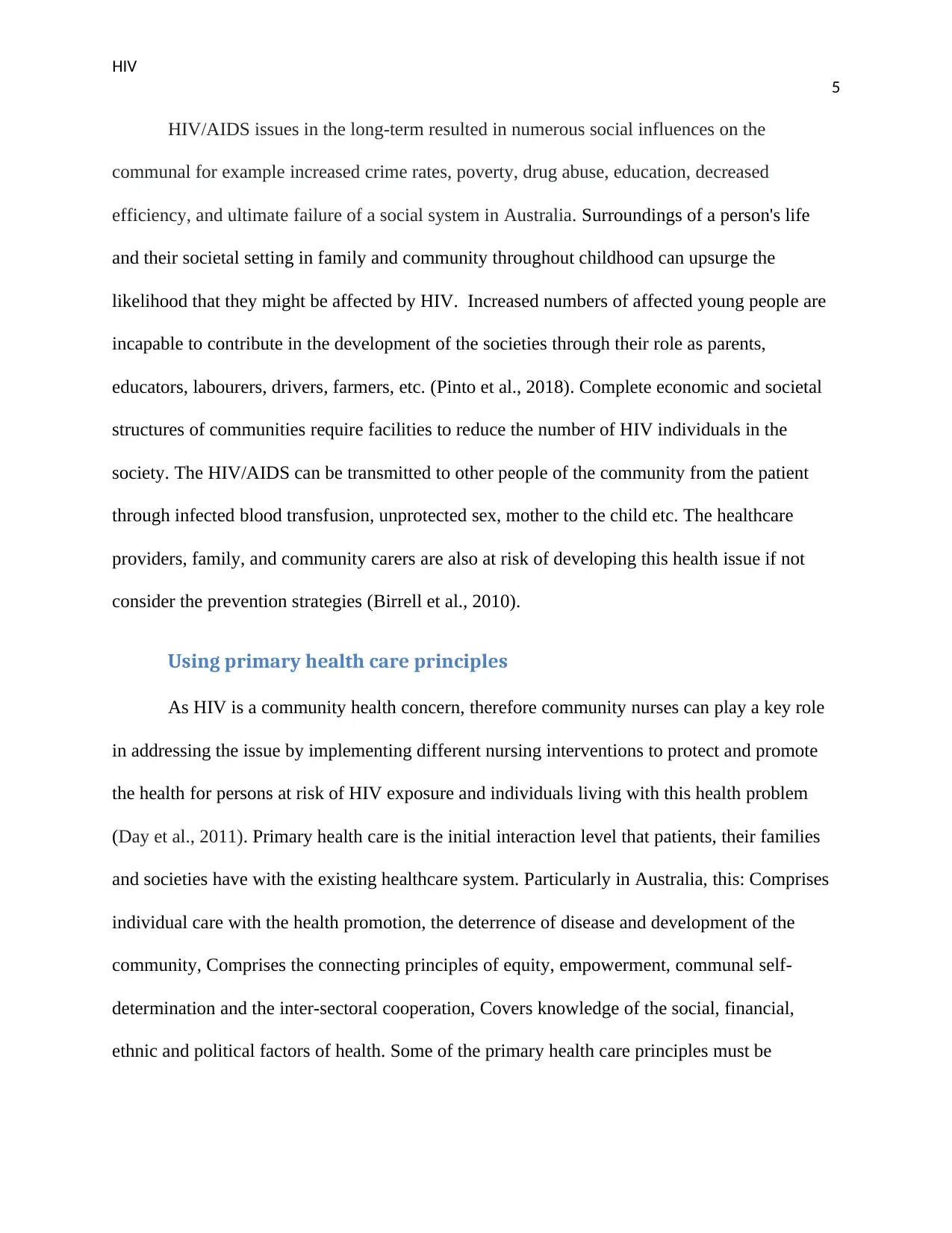
HIV
5
HIV/AIDS issues in the long-term resulted in numerous social influences on the
communal for example increased crime rates, poverty, drug abuse, education, decreased
efficiency, and ultimate failure of a social system in Australia. Surroundings of a person's life
and their societal setting in family and community throughout childhood can upsurge the
likelihood that they might be affected by HIV. Increased numbers of affected young people are
incapable to contribute in the development of the societies through their role as parents,
educators, labourers, drivers, farmers, etc. (Pinto et al., 2018). Complete economic and societal
structures of communities require facilities to reduce the number of HIV individuals in the
society. The HIV/AIDS can be transmitted to other people of the community from the patient
through infected blood transfusion, unprotected sex, mother to the child etc. The healthcare
providers, family, and community carers are also at risk of developing this health issue if not
consider the prevention strategies (Birrell et al., 2010).
Using primary health care principles
As HIV is a community health concern, therefore community nurses can play a key role
in addressing the issue by implementing different nursing interventions to protect and promote
the health for persons at risk of HIV exposure and individuals living with this health problem
(Day et al., 2011). Primary health care is the initial interaction level that patients, their families
and societies have with the existing healthcare system. Particularly in Australia, this: Comprises
individual care with the health promotion, the deterrence of disease and development of the
community, Comprises the connecting principles of equity, empowerment, communal self-
determination and the inter-sectoral cooperation, Covers knowledge of the social, financial,
ethnic and political factors of health. Some of the primary health care principles must be
5
HIV/AIDS issues in the long-term resulted in numerous social influences on the
communal for example increased crime rates, poverty, drug abuse, education, decreased
efficiency, and ultimate failure of a social system in Australia. Surroundings of a person's life
and their societal setting in family and community throughout childhood can upsurge the
likelihood that they might be affected by HIV. Increased numbers of affected young people are
incapable to contribute in the development of the societies through their role as parents,
educators, labourers, drivers, farmers, etc. (Pinto et al., 2018). Complete economic and societal
structures of communities require facilities to reduce the number of HIV individuals in the
society. The HIV/AIDS can be transmitted to other people of the community from the patient
through infected blood transfusion, unprotected sex, mother to the child etc. The healthcare
providers, family, and community carers are also at risk of developing this health issue if not
consider the prevention strategies (Birrell et al., 2010).
Using primary health care principles
As HIV is a community health concern, therefore community nurses can play a key role
in addressing the issue by implementing different nursing interventions to protect and promote
the health for persons at risk of HIV exposure and individuals living with this health problem
(Day et al., 2011). Primary health care is the initial interaction level that patients, their families
and societies have with the existing healthcare system. Particularly in Australia, this: Comprises
individual care with the health promotion, the deterrence of disease and development of the
community, Comprises the connecting principles of equity, empowerment, communal self-
determination and the inter-sectoral cooperation, Covers knowledge of the social, financial,
ethnic and political factors of health. Some of the primary health care principles must be
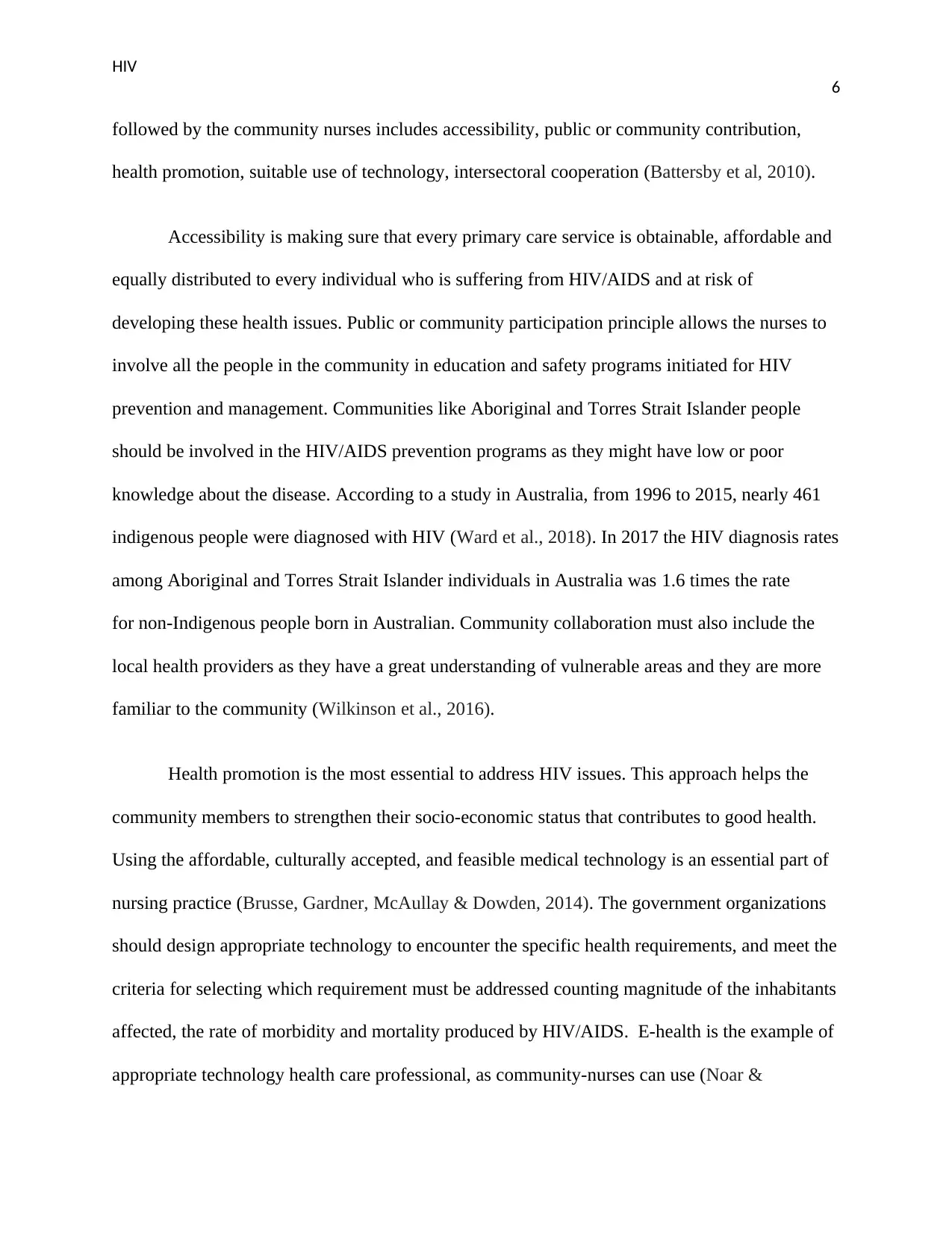
HIV
6
followed by the community nurses includes accessibility, public or community contribution,
health promotion, suitable use of technology, intersectoral cooperation (Battersby et al, 2010).
Accessibility is making sure that every primary care service is obtainable, affordable and
equally distributed to every individual who is suffering from HIV/AIDS and at risk of
developing these health issues. Public or community participation principle allows the nurses to
involve all the people in the community in education and safety programs initiated for HIV
prevention and management. Communities like Aboriginal and Torres Strait Islander people
should be involved in the HIV/AIDS prevention programs as they might have low or poor
knowledge about the disease. According to a study in Australia, from 1996 to 2015, nearly 461
indigenous people were diagnosed with HIV (Ward et al., 2018). In 2017 the HIV diagnosis rates
among Aboriginal and Torres Strait Islander individuals in Australia was 1.6 times the rate
for non-Indigenous people born in Australian. Community collaboration must also include the
local health providers as they have a great understanding of vulnerable areas and they are more
familiar to the community (Wilkinson et al., 2016).
Health promotion is the most essential to address HIV issues. This approach helps the
community members to strengthen their socio-economic status that contributes to good health.
Using the affordable, culturally accepted, and feasible medical technology is an essential part of
nursing practice (Brusse, Gardner, McAullay & Dowden, 2014). The government organizations
should design appropriate technology to encounter the specific health requirements, and meet the
criteria for selecting which requirement must be addressed counting magnitude of the inhabitants
affected, the rate of morbidity and mortality produced by HIV/AIDS. E-health is the example of
appropriate technology health care professional, as community-nurses can use (Noar &
6
followed by the community nurses includes accessibility, public or community contribution,
health promotion, suitable use of technology, intersectoral cooperation (Battersby et al, 2010).
Accessibility is making sure that every primary care service is obtainable, affordable and
equally distributed to every individual who is suffering from HIV/AIDS and at risk of
developing these health issues. Public or community participation principle allows the nurses to
involve all the people in the community in education and safety programs initiated for HIV
prevention and management. Communities like Aboriginal and Torres Strait Islander people
should be involved in the HIV/AIDS prevention programs as they might have low or poor
knowledge about the disease. According to a study in Australia, from 1996 to 2015, nearly 461
indigenous people were diagnosed with HIV (Ward et al., 2018). In 2017 the HIV diagnosis rates
among Aboriginal and Torres Strait Islander individuals in Australia was 1.6 times the rate
for non-Indigenous people born in Australian. Community collaboration must also include the
local health providers as they have a great understanding of vulnerable areas and they are more
familiar to the community (Wilkinson et al., 2016).
Health promotion is the most essential to address HIV issues. This approach helps the
community members to strengthen their socio-economic status that contributes to good health.
Using the affordable, culturally accepted, and feasible medical technology is an essential part of
nursing practice (Brusse, Gardner, McAullay & Dowden, 2014). The government organizations
should design appropriate technology to encounter the specific health requirements, and meet the
criteria for selecting which requirement must be addressed counting magnitude of the inhabitants
affected, the rate of morbidity and mortality produced by HIV/AIDS. E-health is the example of
appropriate technology health care professional, as community-nurses can use (Noar &
Paraphrase This Document
Need a fresh take? Get an instant paraphrase of this document with our AI Paraphraser
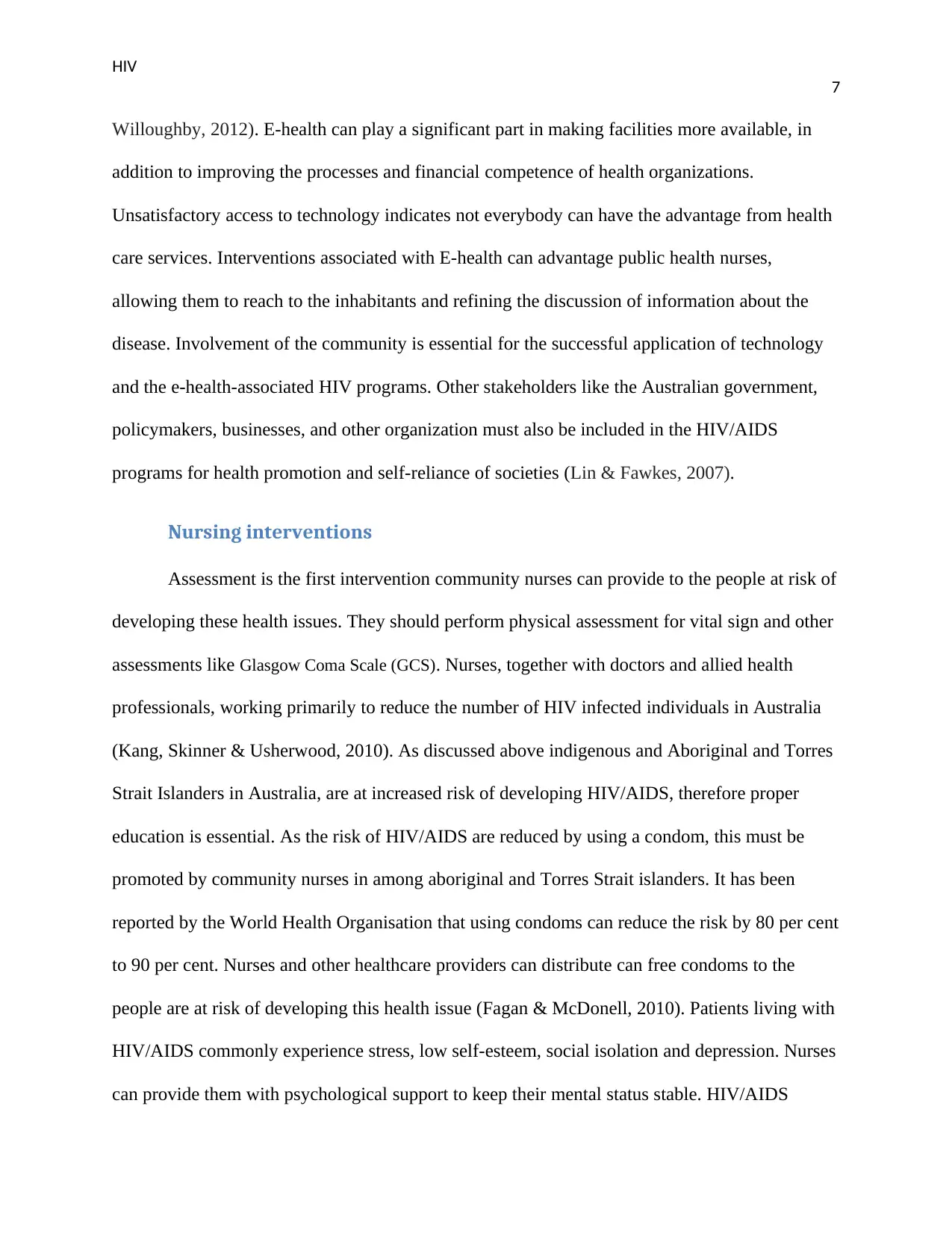
HIV
7
Willoughby, 2012). E-health can play a significant part in making facilities more available, in
addition to improving the processes and financial competence of health organizations.
Unsatisfactory access to technology indicates not everybody can have the advantage from health
care services. Interventions associated with E-health can advantage public health nurses,
allowing them to reach to the inhabitants and refining the discussion of information about the
disease. Involvement of the community is essential for the successful application of technology
and the e-health-associated HIV programs. Other stakeholders like the Australian government,
policymakers, businesses, and other organization must also be included in the HIV/AIDS
programs for health promotion and self-reliance of societies (Lin & Fawkes, 2007).
Nursing interventions
Assessment is the first intervention community nurses can provide to the people at risk of
developing these health issues. They should perform physical assessment for vital sign and other
assessments like Glasgow Coma Scale (GCS). Nurses, together with doctors and allied health
professionals, working primarily to reduce the number of HIV infected individuals in Australia
(Kang, Skinner & Usherwood, 2010). As discussed above indigenous and Aboriginal and Torres
Strait Islanders in Australia, are at increased risk of developing HIV/AIDS, therefore proper
education is essential. As the risk of HIV/AIDS are reduced by using a condom, this must be
promoted by community nurses in among aboriginal and Torres Strait islanders. It has been
reported by the World Health Organisation that using condoms can reduce the risk by 80 per cent
to 90 per cent. Nurses and other healthcare providers can distribute can free condoms to the
people are at risk of developing this health issue (Fagan & McDonell, 2010). Patients living with
HIV/AIDS commonly experience stress, low self-esteem, social isolation and depression. Nurses
can provide them with psychological support to keep their mental status stable. HIV/AIDS
7
Willoughby, 2012). E-health can play a significant part in making facilities more available, in
addition to improving the processes and financial competence of health organizations.
Unsatisfactory access to technology indicates not everybody can have the advantage from health
care services. Interventions associated with E-health can advantage public health nurses,
allowing them to reach to the inhabitants and refining the discussion of information about the
disease. Involvement of the community is essential for the successful application of technology
and the e-health-associated HIV programs. Other stakeholders like the Australian government,
policymakers, businesses, and other organization must also be included in the HIV/AIDS
programs for health promotion and self-reliance of societies (Lin & Fawkes, 2007).
Nursing interventions
Assessment is the first intervention community nurses can provide to the people at risk of
developing these health issues. They should perform physical assessment for vital sign and other
assessments like Glasgow Coma Scale (GCS). Nurses, together with doctors and allied health
professionals, working primarily to reduce the number of HIV infected individuals in Australia
(Kang, Skinner & Usherwood, 2010). As discussed above indigenous and Aboriginal and Torres
Strait Islanders in Australia, are at increased risk of developing HIV/AIDS, therefore proper
education is essential. As the risk of HIV/AIDS are reduced by using a condom, this must be
promoted by community nurses in among aboriginal and Torres Strait islanders. It has been
reported by the World Health Organisation that using condoms can reduce the risk by 80 per cent
to 90 per cent. Nurses and other healthcare providers can distribute can free condoms to the
people are at risk of developing this health issue (Fagan & McDonell, 2010). Patients living with
HIV/AIDS commonly experience stress, low self-esteem, social isolation and depression. Nurses
can provide them with psychological support to keep their mental status stable. HIV/AIDS
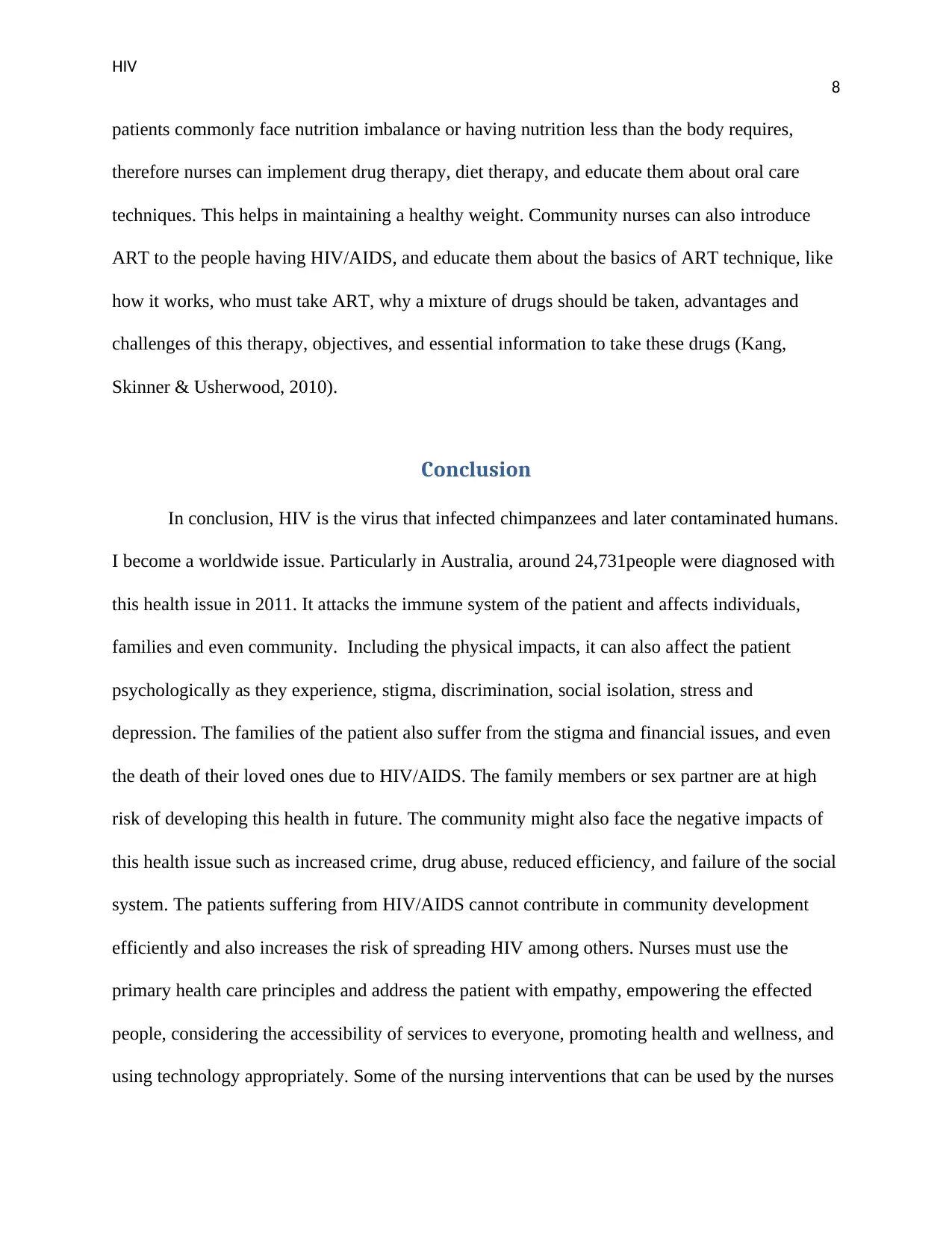
HIV
8
patients commonly face nutrition imbalance or having nutrition less than the body requires,
therefore nurses can implement drug therapy, diet therapy, and educate them about oral care
techniques. This helps in maintaining a healthy weight. Community nurses can also introduce
ART to the people having HIV/AIDS, and educate them about the basics of ART technique, like
how it works, who must take ART, why a mixture of drugs should be taken, advantages and
challenges of this therapy, objectives, and essential information to take these drugs (Kang,
Skinner & Usherwood, 2010).
Conclusion
In conclusion, HIV is the virus that infected chimpanzees and later contaminated humans.
I become a worldwide issue. Particularly in Australia, around 24,731people were diagnosed with
this health issue in 2011. It attacks the immune system of the patient and affects individuals,
families and even community. Including the physical impacts, it can also affect the patient
psychologically as they experience, stigma, discrimination, social isolation, stress and
depression. The families of the patient also suffer from the stigma and financial issues, and even
the death of their loved ones due to HIV/AIDS. The family members or sex partner are at high
risk of developing this health in future. The community might also face the negative impacts of
this health issue such as increased crime, drug abuse, reduced efficiency, and failure of the social
system. The patients suffering from HIV/AIDS cannot contribute in community development
efficiently and also increases the risk of spreading HIV among others. Nurses must use the
primary health care principles and address the patient with empathy, empowering the effected
people, considering the accessibility of services to everyone, promoting health and wellness, and
using technology appropriately. Some of the nursing interventions that can be used by the nurses
8
patients commonly face nutrition imbalance or having nutrition less than the body requires,
therefore nurses can implement drug therapy, diet therapy, and educate them about oral care
techniques. This helps in maintaining a healthy weight. Community nurses can also introduce
ART to the people having HIV/AIDS, and educate them about the basics of ART technique, like
how it works, who must take ART, why a mixture of drugs should be taken, advantages and
challenges of this therapy, objectives, and essential information to take these drugs (Kang,
Skinner & Usherwood, 2010).
Conclusion
In conclusion, HIV is the virus that infected chimpanzees and later contaminated humans.
I become a worldwide issue. Particularly in Australia, around 24,731people were diagnosed with
this health issue in 2011. It attacks the immune system of the patient and affects individuals,
families and even community. Including the physical impacts, it can also affect the patient
psychologically as they experience, stigma, discrimination, social isolation, stress and
depression. The families of the patient also suffer from the stigma and financial issues, and even
the death of their loved ones due to HIV/AIDS. The family members or sex partner are at high
risk of developing this health in future. The community might also face the negative impacts of
this health issue such as increased crime, drug abuse, reduced efficiency, and failure of the social
system. The patients suffering from HIV/AIDS cannot contribute in community development
efficiently and also increases the risk of spreading HIV among others. Nurses must use the
primary health care principles and address the patient with empathy, empowering the effected
people, considering the accessibility of services to everyone, promoting health and wellness, and
using technology appropriately. Some of the nursing interventions that can be used by the nurses
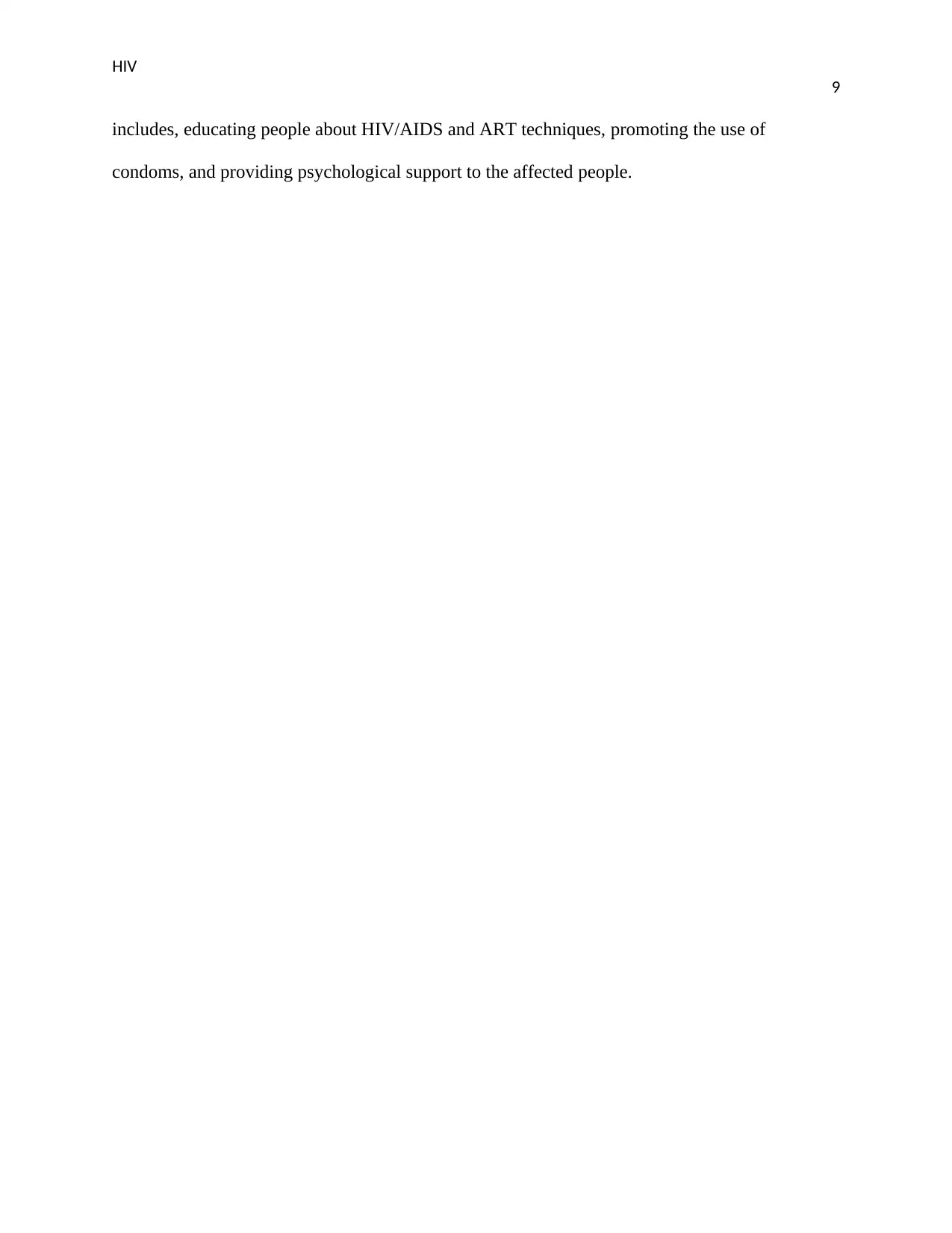
HIV
9
includes, educating people about HIV/AIDS and ART techniques, promoting the use of
condoms, and providing psychological support to the affected people.
9
includes, educating people about HIV/AIDS and ART techniques, promoting the use of
condoms, and providing psychological support to the affected people.
Secure Best Marks with AI Grader
Need help grading? Try our AI Grader for instant feedback on your assignments.
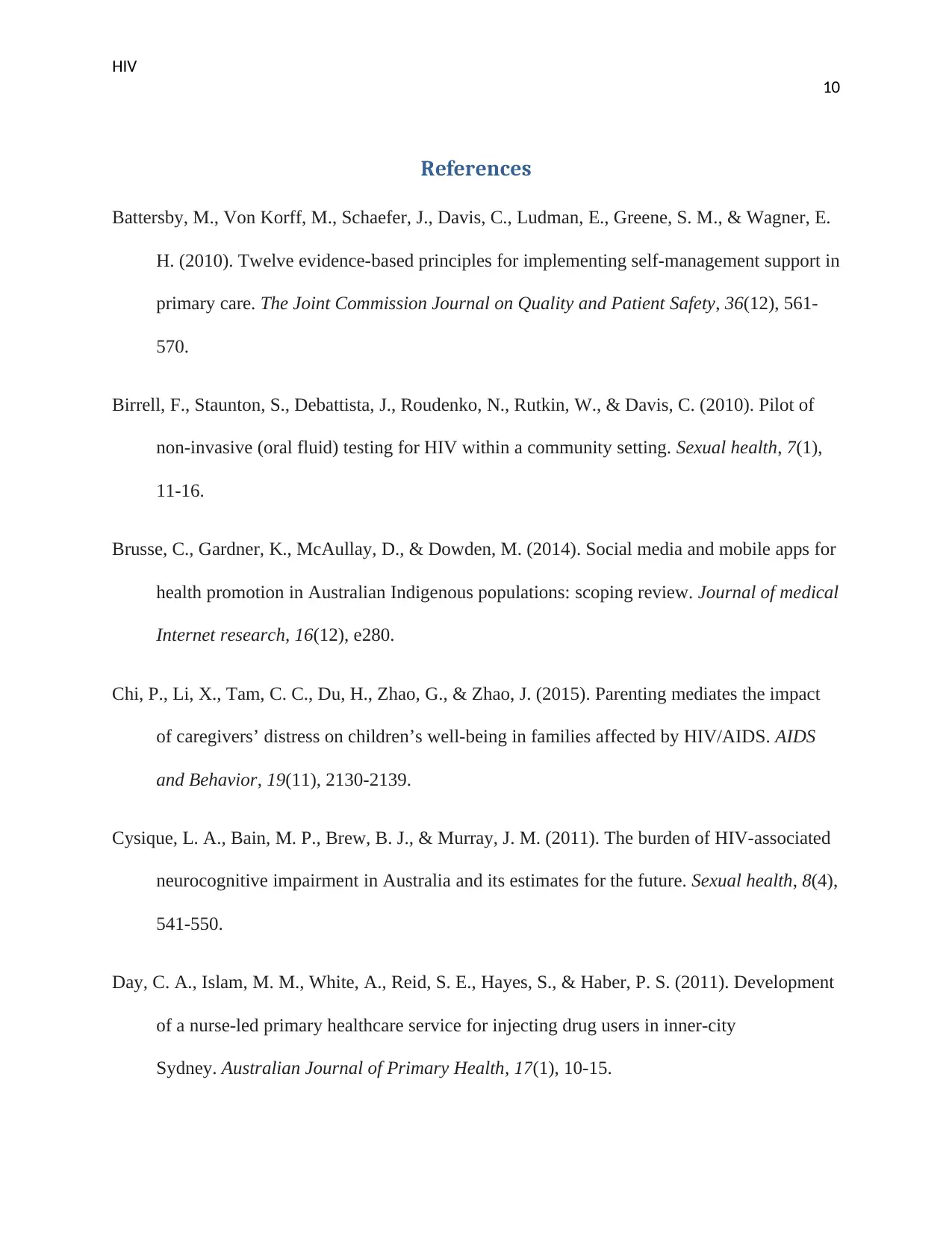
HIV
10
References
Battersby, M., Von Korff, M., Schaefer, J., Davis, C., Ludman, E., Greene, S. M., & Wagner, E.
H. (2010). Twelve evidence-based principles for implementing self-management support in
primary care. The Joint Commission Journal on Quality and Patient Safety, 36(12), 561-
570.
Birrell, F., Staunton, S., Debattista, J., Roudenko, N., Rutkin, W., & Davis, C. (2010). Pilot of
non-invasive (oral fluid) testing for HIV within a community setting. Sexual health, 7(1),
11-16.
Brusse, C., Gardner, K., McAullay, D., & Dowden, M. (2014). Social media and mobile apps for
health promotion in Australian Indigenous populations: scoping review. Journal of medical
Internet research, 16(12), e280.
Chi, P., Li, X., Tam, C. C., Du, H., Zhao, G., & Zhao, J. (2015). Parenting mediates the impact
of caregivers’ distress on children’s well-being in families affected by HIV/AIDS. AIDS
and Behavior, 19(11), 2130-2139.
Cysique, L. A., Bain, M. P., Brew, B. J., & Murray, J. M. (2011). The burden of HIV-associated
neurocognitive impairment in Australia and its estimates for the future. Sexual health, 8(4),
541-550.
Day, C. A., Islam, M. M., White, A., Reid, S. E., Hayes, S., & Haber, P. S. (2011). Development
of a nurse-led primary healthcare service for injecting drug users in inner-city
Sydney. Australian Journal of Primary Health, 17(1), 10-15.
10
References
Battersby, M., Von Korff, M., Schaefer, J., Davis, C., Ludman, E., Greene, S. M., & Wagner, E.
H. (2010). Twelve evidence-based principles for implementing self-management support in
primary care. The Joint Commission Journal on Quality and Patient Safety, 36(12), 561-
570.
Birrell, F., Staunton, S., Debattista, J., Roudenko, N., Rutkin, W., & Davis, C. (2010). Pilot of
non-invasive (oral fluid) testing for HIV within a community setting. Sexual health, 7(1),
11-16.
Brusse, C., Gardner, K., McAullay, D., & Dowden, M. (2014). Social media and mobile apps for
health promotion in Australian Indigenous populations: scoping review. Journal of medical
Internet research, 16(12), e280.
Chi, P., Li, X., Tam, C. C., Du, H., Zhao, G., & Zhao, J. (2015). Parenting mediates the impact
of caregivers’ distress on children’s well-being in families affected by HIV/AIDS. AIDS
and Behavior, 19(11), 2130-2139.
Cysique, L. A., Bain, M. P., Brew, B. J., & Murray, J. M. (2011). The burden of HIV-associated
neurocognitive impairment in Australia and its estimates for the future. Sexual health, 8(4),
541-550.
Day, C. A., Islam, M. M., White, A., Reid, S. E., Hayes, S., & Haber, P. S. (2011). Development
of a nurse-led primary healthcare service for injecting drug users in inner-city
Sydney. Australian Journal of Primary Health, 17(1), 10-15.
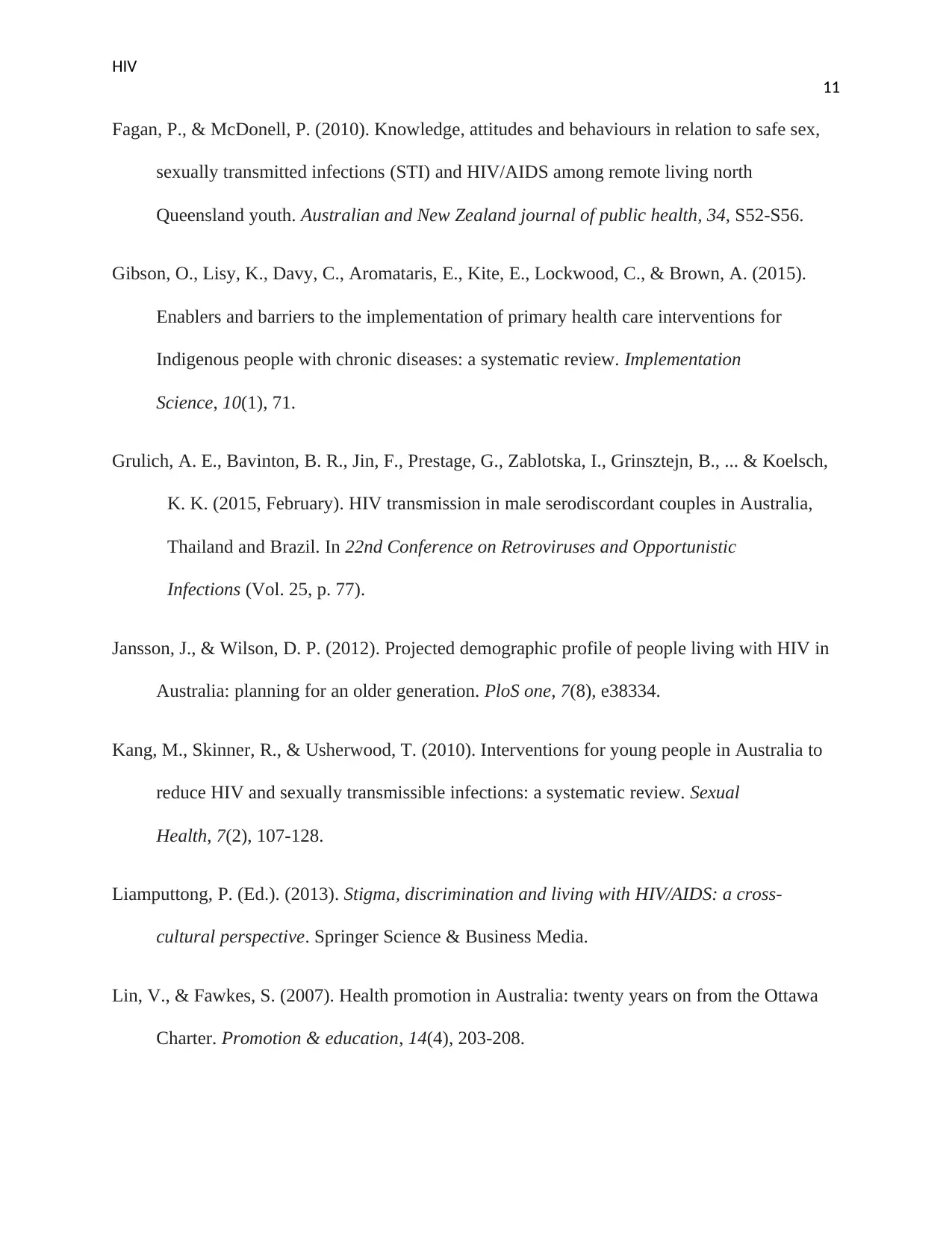
HIV
11
Fagan, P., & McDonell, P. (2010). Knowledge, attitudes and behaviours in relation to safe sex,
sexually transmitted infections (STI) and HIV/AIDS among remote living north
Queensland youth. Australian and New Zealand journal of public health, 34, S52-S56.
Gibson, O., Lisy, K., Davy, C., Aromataris, E., Kite, E., Lockwood, C., & Brown, A. (2015).
Enablers and barriers to the implementation of primary health care interventions for
Indigenous people with chronic diseases: a systematic review. Implementation
Science, 10(1), 71.
Grulich, A. E., Bavinton, B. R., Jin, F., Prestage, G., Zablotska, I., Grinsztejn, B., ... & Koelsch,
K. K. (2015, February). HIV transmission in male serodiscordant couples in Australia,
Thailand and Brazil. In 22nd Conference on Retroviruses and Opportunistic
Infections (Vol. 25, p. 77).
Jansson, J., & Wilson, D. P. (2012). Projected demographic profile of people living with HIV in
Australia: planning for an older generation. PloS one, 7(8), e38334.
Kang, M., Skinner, R., & Usherwood, T. (2010). Interventions for young people in Australia to
reduce HIV and sexually transmissible infections: a systematic review. Sexual
Health, 7(2), 107-128.
Liamputtong, P. (Ed.). (2013). Stigma, discrimination and living with HIV/AIDS: a cross-
cultural perspective. Springer Science & Business Media.
Lin, V., & Fawkes, S. (2007). Health promotion in Australia: twenty years on from the Ottawa
Charter. Promotion & education, 14(4), 203-208.
11
Fagan, P., & McDonell, P. (2010). Knowledge, attitudes and behaviours in relation to safe sex,
sexually transmitted infections (STI) and HIV/AIDS among remote living north
Queensland youth. Australian and New Zealand journal of public health, 34, S52-S56.
Gibson, O., Lisy, K., Davy, C., Aromataris, E., Kite, E., Lockwood, C., & Brown, A. (2015).
Enablers and barriers to the implementation of primary health care interventions for
Indigenous people with chronic diseases: a systematic review. Implementation
Science, 10(1), 71.
Grulich, A. E., Bavinton, B. R., Jin, F., Prestage, G., Zablotska, I., Grinsztejn, B., ... & Koelsch,
K. K. (2015, February). HIV transmission in male serodiscordant couples in Australia,
Thailand and Brazil. In 22nd Conference on Retroviruses and Opportunistic
Infections (Vol. 25, p. 77).
Jansson, J., & Wilson, D. P. (2012). Projected demographic profile of people living with HIV in
Australia: planning for an older generation. PloS one, 7(8), e38334.
Kang, M., Skinner, R., & Usherwood, T. (2010). Interventions for young people in Australia to
reduce HIV and sexually transmissible infections: a systematic review. Sexual
Health, 7(2), 107-128.
Liamputtong, P. (Ed.). (2013). Stigma, discrimination and living with HIV/AIDS: a cross-
cultural perspective. Springer Science & Business Media.
Lin, V., & Fawkes, S. (2007). Health promotion in Australia: twenty years on from the Ottawa
Charter. Promotion & education, 14(4), 203-208.
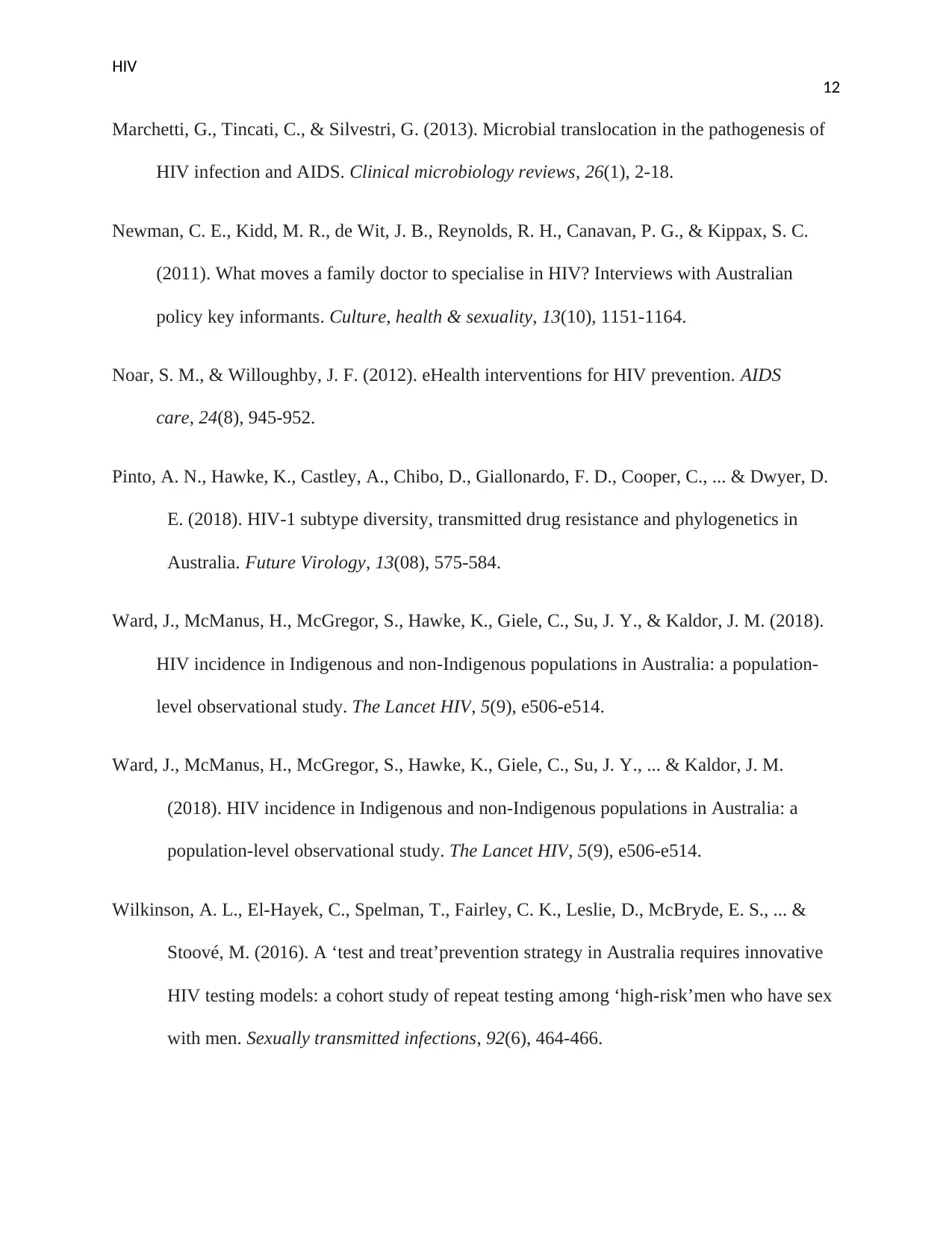
HIV
12
Marchetti, G., Tincati, C., & Silvestri, G. (2013). Microbial translocation in the pathogenesis of
HIV infection and AIDS. Clinical microbiology reviews, 26(1), 2-18.
Newman, C. E., Kidd, M. R., de Wit, J. B., Reynolds, R. H., Canavan, P. G., & Kippax, S. C.
(2011). What moves a family doctor to specialise in HIV? Interviews with Australian
policy key informants. Culture, health & sexuality, 13(10), 1151-1164.
Noar, S. M., & Willoughby, J. F. (2012). eHealth interventions for HIV prevention. AIDS
care, 24(8), 945-952.
Pinto, A. N., Hawke, K., Castley, A., Chibo, D., Giallonardo, F. D., Cooper, C., ... & Dwyer, D.
E. (2018). HIV-1 subtype diversity, transmitted drug resistance and phylogenetics in
Australia. Future Virology, 13(08), 575-584.
Ward, J., McManus, H., McGregor, S., Hawke, K., Giele, C., Su, J. Y., & Kaldor, J. M. (2018).
HIV incidence in Indigenous and non-Indigenous populations in Australia: a population-
level observational study. The Lancet HIV, 5(9), e506-e514.
Ward, J., McManus, H., McGregor, S., Hawke, K., Giele, C., Su, J. Y., ... & Kaldor, J. M.
(2018). HIV incidence in Indigenous and non-Indigenous populations in Australia: a
population-level observational study. The Lancet HIV, 5(9), e506-e514.
Wilkinson, A. L., El-Hayek, C., Spelman, T., Fairley, C. K., Leslie, D., McBryde, E. S., ... &
Stoové, M. (2016). A ‘test and treat’prevention strategy in Australia requires innovative
HIV testing models: a cohort study of repeat testing among ‘high-risk’men who have sex
with men. Sexually transmitted infections, 92(6), 464-466.
12
Marchetti, G., Tincati, C., & Silvestri, G. (2013). Microbial translocation in the pathogenesis of
HIV infection and AIDS. Clinical microbiology reviews, 26(1), 2-18.
Newman, C. E., Kidd, M. R., de Wit, J. B., Reynolds, R. H., Canavan, P. G., & Kippax, S. C.
(2011). What moves a family doctor to specialise in HIV? Interviews with Australian
policy key informants. Culture, health & sexuality, 13(10), 1151-1164.
Noar, S. M., & Willoughby, J. F. (2012). eHealth interventions for HIV prevention. AIDS
care, 24(8), 945-952.
Pinto, A. N., Hawke, K., Castley, A., Chibo, D., Giallonardo, F. D., Cooper, C., ... & Dwyer, D.
E. (2018). HIV-1 subtype diversity, transmitted drug resistance and phylogenetics in
Australia. Future Virology, 13(08), 575-584.
Ward, J., McManus, H., McGregor, S., Hawke, K., Giele, C., Su, J. Y., & Kaldor, J. M. (2018).
HIV incidence in Indigenous and non-Indigenous populations in Australia: a population-
level observational study. The Lancet HIV, 5(9), e506-e514.
Ward, J., McManus, H., McGregor, S., Hawke, K., Giele, C., Su, J. Y., ... & Kaldor, J. M.
(2018). HIV incidence in Indigenous and non-Indigenous populations in Australia: a
population-level observational study. The Lancet HIV, 5(9), e506-e514.
Wilkinson, A. L., El-Hayek, C., Spelman, T., Fairley, C. K., Leslie, D., McBryde, E. S., ... &
Stoové, M. (2016). A ‘test and treat’prevention strategy in Australia requires innovative
HIV testing models: a cohort study of repeat testing among ‘high-risk’men who have sex
with men. Sexually transmitted infections, 92(6), 464-466.
1 out of 13
Related Documents
Your All-in-One AI-Powered Toolkit for Academic Success.
+13062052269
info@desklib.com
Available 24*7 on WhatsApp / Email
![[object Object]](/_next/static/media/star-bottom.7253800d.svg)
Unlock your academic potential
© 2024 | Zucol Services PVT LTD | All rights reserved.





